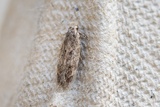Borkhausenia fuscescens (Haworth, 1828) Species
Last modified: Dec. 8, 2025, 5:34 p.m.
A locally fairly common species, though widespread in Belgium, especially in the northern part of the country.
Details
- Classification
- Family: Oecophoridae > Subfamily: Oecophorinae > Genus: Borkhausenia > Species: Borkhausenia fuscescens
- Vernacular names
- Dwergsikkelmot (NL)
- First mention in Belgium
- Fologne E. 1859b. Supplément au catalogue des lépidoptères de Belgique. — Annales de la Société entomologique belge 3: 133–142. On page 136 (as OEcophora fuscescens. Haw.; Wd.). view page
- Status
-
Native
Distribution
Caterpillar
Greyish white; head capsule very light brown, prothoracic plate even lighter brown, last abdominal segment pale yellow; thoracic legs transparent.
Bionomics
The species hibernates in the larval stage. The caterpillar constructs a silken tube in which frass is used. The tube is attached to leaves among leaf litter just below the surface. The larva feeds from October to April.
Pupation in a white silken cocoon in the larval feeding place, in May–June.
The adults fly in late evening and later come to light. They are more often found indoors than outside in nature.
Flight periods
One generation a year from mid-June till August.
Observed on
- Substrates:
- Dead leaves and Nests of birds
The larva lives on plant material like dead leaves, and also in birds' nests. Leaves can be of very different species of trees; larval tubes have been found on leaves of: Chamaecyparis, Hedera helix, Ilex aquifolium and Quercus.
Habitat
Localities with a lot of dead wood, abandoned gardens, parks, stables, barns, etc.




